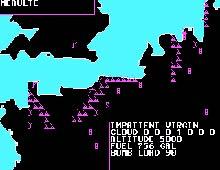‘”Help him. Help him” Dobbs sobbed. “Help him”
“Help who? Help who?” called Yossarian once he could wrestle his headset back into the intercom. “Help who?”
“The bombadier. The bombadier. Help the bombadier”
“I’m the bombadier” Yossarian yelled right back to him. “I’m the bombadier, I’m all right, I’m all right.”
“Then help him, help him” Dobbs begged. “Help him. Help the bombadier.”
And Snowden lay dying in the back.
–Joseph Heller, Catch-22
It’s a silly little thing, really. Just a tradition. When I crew my first bomber in the classic SSI Apple ][ game Fifty Mission Crush, I name the crew members after characters from Catch-22. The pilot will be Orr or McWatt, Snowden is the tailgunner, Aarfy is the radioman, and of course the bombadier has to be Yossarian. Various other minor characters from the book fill out the other positions.
This leads to a problem, of course, when you take heavy flak over Lille and Aarfy (for example) dies. Who takes his place? You could of course hypothesize that Aarfy Junior joined the service also, or that Aarfy has a clone, suitably named "Aarfy 2," but that somehow isn't quite as satisfying. Consequently, I tend to get attached to the first generation of each crewman, perhaps mostly because it's such a pain to come up with a new name if they die.
So like a sense of place, a sense of personality can increase a player's engagement in a game. Personality can come from the game's designers, who deliberately create personality through character and plot design, or cut scenes, as in The Mark of Kri, or in the worst case personality can be provided in the accompanying manual (How can you tell I'm old? I remember when games came with printed manuals, and the size and quality of the manual was considered to be a good indicator of the quality of the game. How naive we were then). The problem here is that not all game designers are good storytellers, by which I mean "most game designers are not good storytellers." So if you provide a character that is stupid, you lose (look at the universally negative reaction Kojima got to the "twist" in the middle of Metal Gear Solid 2. People didn't like the character, and that translated to "people didn't like that part of the game.")
The other route is for the designer to allow the player to define the personality of the character; this is the route that most American-style role playing games take (but not their Japanese cousins). It's a riskier strategy. If it pays off, then the player has an extremely immersive experience and feels empowered (you'll hear people raving about Morrowind, for example, because it "lets them be whatever they want to be.") But the flip side of "empowered" is "directionless." Since the player will get out of a game like this what they put into it, to a casual player (say, one that is just evaluating the game to see if they like it) this type of game will seem bland. Without personality.
The third path is to try to allow for the player to decide in what directions their character or characters develop, and to provide scripted personality development accordingly. The downside of this is that you're multiplying the amount of work you need to do, because you need to provide personality and narrative along several axes. Bioware and Black Isle have both done this with a few of their games. The only one where I thought they really pulled it off was in the superb Planescape: Torment, although Fallout came close.
There's a belief that is rampant among developers that writing well is easy. It's not. Telling a good story is harder than developing a complex piece of software. So I think where I come down on this from a design perspective is: if you aren't positive that you (or someone you collaborate with) can write a good story and tell it well, punt. Give the user some way to customize the character and invest her own chosen personality in her avatar, and get the hell out of her way.

Fifty Mission Crush
And, to tell the whole truth, when we're bombing Rotterdam from 30,000 feet I really do imagine Yossarian there in the bombadier's nest, not caring if he hits the target, just wanting to unload his payload close enough to avoid court-martial. And I feel a little -- just a little -- sad when he dies. Conversely, since at the start of every mission you get a brief report showing you who is crewing your plane and how many missions they've survived for, there's a little thrill to know that you've managed through skill (read: luck) to keep one of these guys alive for 10 or 20 missions (in Fifty Mission Crush, life is cheap, not to mention short).
It has no plot to speak of, but 20 years later, I'm still playing Fifty Mission Crush. I'm still trying to keep Yossarian alive.
"I'm cold," Snowden said. "I'm cold."
"There, there," said Yossarian. "There, there." He pulled the rip cord of Snowden's parachute and covered his body with the white nylon sheets.
"I'm cold."
"There, there."
Additional Resources
Ou sont les neigedens d'antan?
- You can obtain a DOS version of Fifty Mission Crush from The Underdogs
- The manual for Fifty Mission Crush
- If you have an Apple ][ emulator (and who doesn’t?) you can get the Apple version of Fifty Mission Crush.
- Bombs Away is a great site dedicated to B-17 (and related aircraft) videogames. Who knew?
- A memoir of the same name by the navigator of a B-24 bomber during World War II.




